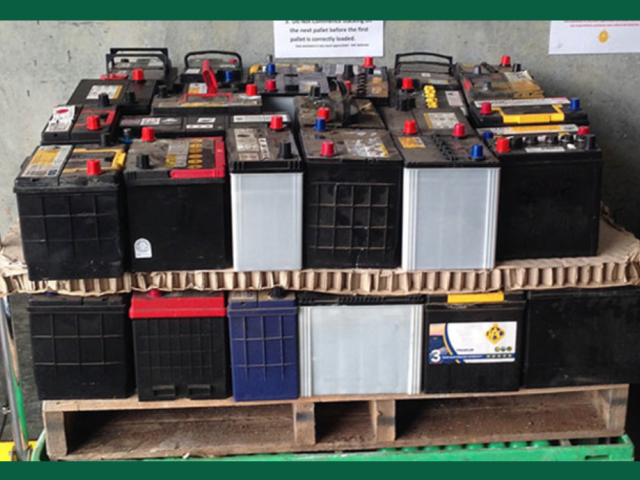Spec Sheet: Lead Acid Automotive Batteries
 Hundreds of thousands of lead-acid batteries are discarded each year. A typical lead-acid battery used in a car or truck contains sulfuric acid and 18 to 20 pounds of lead. Lead, a toxic heavy metal, can pose serious health issues and adversely affect the environment if disposed of improperly by contaminating ground water and surface water.
Hundreds of thousands of lead-acid batteries are discarded each year. A typical lead-acid battery used in a car or truck contains sulfuric acid and 18 to 20 pounds of lead. Lead, a toxic heavy metal, can pose serious health issues and adversely affect the environment if disposed of improperly by contaminating ground water and surface water.
Recycling lead-acid batteries through NRRA not only conserves valuable landfill space, keeps potential harmful products out of the waste stream and saves members’ tax dollars, but it also strengthens recycling!
- DECIDE if residents will be charged a fee for disposing of lead-acid batteries at the recycling facility.
- CONTACT NRRA at info@nrrarecyles.org or (603) 736-4401 to coordinate delivery or pick up of the lead-acid batteries to the recycling facility. A minimum of two pallets, double-stacked are required for pick up.
What happens to lead acid batteries once they leave your site?
Once our vendor picks up the batteries at members’ sites, they are brought to our vendor’s warehouse. Batteries are stored there only until vendor gets their new battery deliveries each week. The scrap batteries are loaded onto the delivery truck and taken to be recycled at an EPA approved smelter in US or Canada.
Lead acid batteries are 100% recyclable and have the highest recycling rate of any product sold in the United States (99% per the EPA). This is in part because of the value of the lead components of the used battery.
Program Details
The following Lead Acid Batteries are accepted:
- Large (automotive/motorcycle) sealed lead-acid batteries
- Small (powered toys/electronics) sealed lead-acid batteries
- must say "lead-acid" on the battery
- store in 5-gallon pails with lids on a pallet
- UPS (Uninterruptible power supply) batteries
- Jump start battery packs (w/plastic housing) accepted
- place separately or on top of other batteries
Packaging Instructions
- Detailed instructions on how to stack and wrap used batteries on pallets (courtesy of East Penn Manufacturing)
- Stack batteries on a pallet, two (up to three) layers high
- MUST place a layer of cardboard on the pallet first before stacking and then place cardboard between each later thereafter
- Arrange batteries so that terminals do not touch
- Arrange larger sized batteries on the perimeter, so that if a collapse does occur, it will collapse inward
- Make sure there are no overhanging batteries. Shrink wrap batteries (if possible)
DO NOT include electric car batteries with lead acid batteries
- DO NOT include Lithium-ion (Li-ion) batteries with lead acid batteries
Packing Example:

